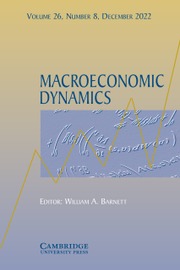Article contents
ENDOGENOUS SHORT-SALE CONSTRAINT, STOCK PRICESAND OUTPUT CYCLES
Published online by Cambridge University Press: 02 March 2005
Extract
This study examines the effect of short-sale constraints on a stockmarket, in particular, on stock prices, trading volume, and therelationship between stock price movements and output cycles.Theeconomic model features incomplete markets and heterogeneous agents.The short-sale constraint is endogenously determined in the economyand is a function of agents' risk aversion, time preference, andexogenous driving forces. The dynamic model is solved using a policyfunction iteration algorithm. We find that, for an array ofreasonable time-preference parameters and risk-aversion coefficients, the short sale limits range from 27 to 45% of total outstandingshares. Imposing short-sale constraints causes stock prices to moveupward. Trading volume is high when some agents have a large amount ofstock holdings but incur a negative shock on their nonfinancialincome and is low when some agents have few stock holdings and alsoincur a negative shock to their nonfinancial income. Stock prices arefound to be countercyclical and the expected stock returns areprocyclical. These countercyclical stock-price movements are shownto be related to the imposition of a short-sale constraint.
Information
- Type
- Research Article
- Information
- Copyright
- © 1997 Cambridge University Press
- 13
- Cited by

